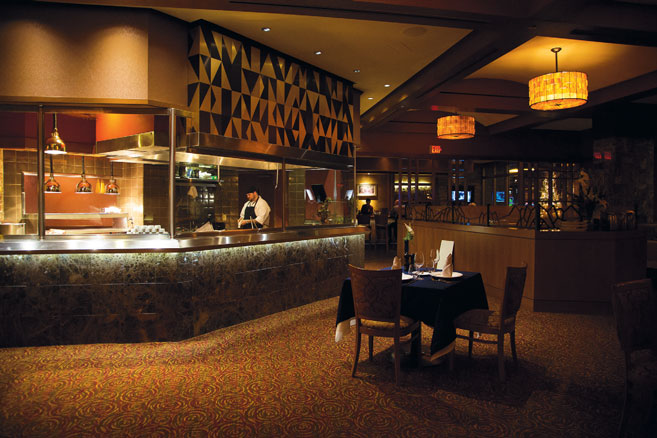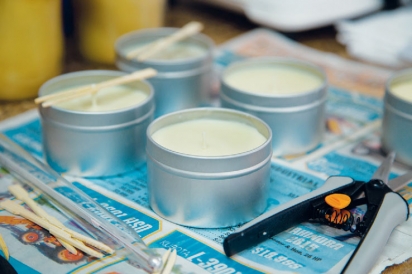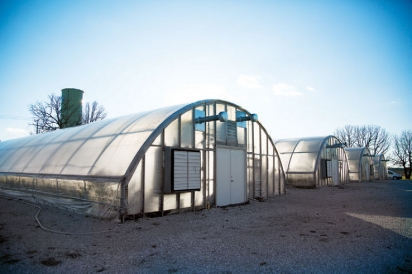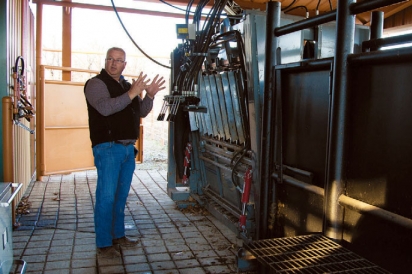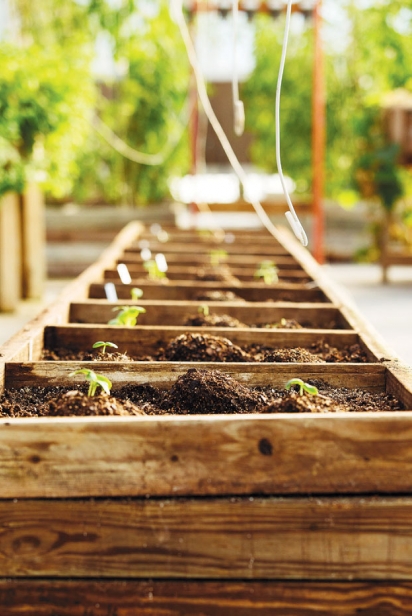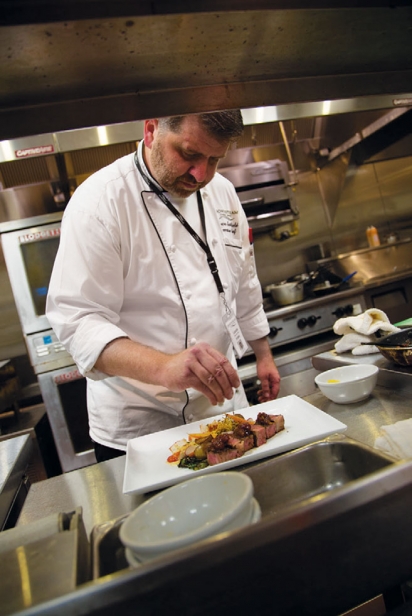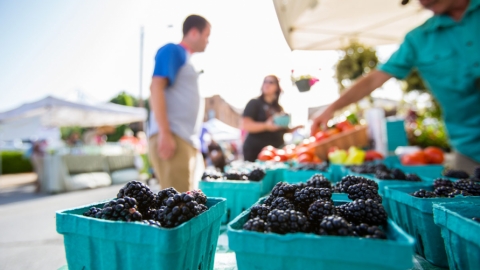Bison, Beef and Bees
The Quapaw Tribe’s agriculture program brings the farm to the casino.
Just up the road from the Quapaw Tribe’s Downstream Casino Resort, Ranch Manager Chris Roper is standing outside a small pasture watching a handful of bison graze lazily. Slated for slaughter in the coming month, these bison will also make their way to the resort’s Red Oak Steakhouse, where they will be featured alongside other Quapaw Cattle Company prime beef selections.
Just beyond the casino’s footprint, which straddles the Oklahoma-Kansas state line, lie various elements of the Quapaws’ emerging agriculture program: grazing pastures for cattle and bison, the ranch’s working facility, beehives and a row of greenhouses which supply fresh herbs and vegetables to the casino’s restaurants and spa. Lush tropical plants that line the resort’s halls are not imported from some exotics dealer but grown and cared for in these greenhouses.
With ever growing demand for organic, locally sourced menu items, this might seem like an effort by the casino to jump on the farm-to-table bandwagon. In fact, the tribe is relatively quiet about its commitment to sourcing fresh, healthy products for their restaurants.
“In terms of what we really do to set ourselves apart, the tribe is a modest one,” says Lucus Setterfield, Downstream’s executive chef, who oversees all five of the casino’s restaurants, in addition to a growing banquet department and an employee dining lounge that serves around 800 people each day. Weaving in products from the casino’s backyard requires constant coordination but it’s what makes it a dream job for Chef Setterfield.
“The job is always stressful. Everybody’s job is, whenever you take on this much responsibility—trying to make sure things are being utilized and trying to make sure things are going in the right direction—but you’re not going to find this anywhere else. I couldn’t go out and expect to find a job like this one where I have so much right at my fingertips.”
The Quapaws’ robust agriculture program is clearly more than a marketing ploy. It reflects a deeper commitment to quality and human connections. Chairman John Berrey explains that his decision to expand programming beyond the walls of the casino was rooted in the history of his people:
“As Native American people, we very much try to have daily contact with nature.”
Darting between these two contrasting yet intertwined operations, the casino and the agriculture program, it’s hard not view the Quapaws’ efforts through the long lens of history, for the rise and fall of bison in North American is inextricably tied to the fate of the indigenous people. Bison once roamed the prairie in herds over a million strong. Native Americans plucked delicately from the bison population, hunting only as needed and utilizing every part of the downed animal, from horn to hide.
“The Indian was frugal in the midst of plenty,” Luther Standing Bear of the Lakota Tribe explains in the PBS documentary “American Buffalo: Spirit of a Nation.”
This relatively peaceful coexistence shifted, however, with the introduction first of horses by Spanish explorers and, later, of guns and trains. Wielding disproportionate power and efficiency, white settlers chipped away at the herds, killing for sport, trade and to strategically cut off the Native American food supply. Buffalo populations dwindled dramatically to just a few hundred animals and as bison lost their foothold on the prairie, so too did the Native Americans. Euro-American settlers sprawled across the country, pushing the indigenous people from their homelands and into a new way of life.
Today, Native American wealth is associated less with the land and more with gaming, thanks in part to a 1987 ruling by the U.S. Supreme Court stating that sovereign tribes can’t be barred from gambling. Nearly half of the United States’ tribes operate casinos, more than 70 of which are located in Oklahoma. Casinos, a symbol of excess, conjure images of bright blinking lights, the ding-a-ling of slot machines, cocktails floating around the room by the tray full. In so many ways, casinos are at odds with a nostalgic view of Native American prudence.
Which is what makes the Quapaw Tribe’s approach to agriculture so striking. Not content to ply the casino’s restaurants with perfectly price-pointed mass-distributor products, in 2014 the tribe acquired 140 Angus cattle, marking the beginning of the Quapaw Cattle Company. Today the cattle, along with 130 bison, are scattered over 1,200 acres of ranchland. The ranch’s working facility features a massive metal maze that funnels into a button-and-lever controlled device resembling a torture chamber. In fact, the system is quite the opposite.
“The whole thing is a Temple Grandin design,” Chris Roper explains, referring to the world-renowned professor of livestock behavior and welfare, whose research and designs are widely used to reduce animal stress and improve their care. The curved chute system confines and narrows the cattle’s vision so they remain calm as they are led into the squeeze chutes. Once in the squeeze chutes, the animal is restrained through a compression mechanism, which calms the animal and allows the ranchers to move it as they check eyes, ears, horns and bodies. Roper says they try to handle the animals as little as possible.
“From her teachings we’ve learned that it enhances the flavor if you treat an animal with great kindness from birth to death,” Chairman Berrey says of the tribe’s work with Dr. Grandin, noting that fear and stress in an animal impact the quality of meat.
In addition to overall care for the animals, the Quapaw Cattle Company endeavors to use as much of the processed animals as possible. “We provide bison meat to our elder center and day cares,” says Roper. “We don’t process a lot, just enough to keep ourselves going.”
Says Roper, “We save the capes and we save the heads. We save as much as we can of the overall product. It’ll be used in cultural ceremonies and things like that.” Excess product is also processed into jerky and dog bones, which are sold at the Q Store convenience store, just off Highway 400.
***
The Quapaw, or “Downstream People,” are so named not for their present day position in the far northeast corner of Oklahoma but for an event that set them apart centuries ago. Legend has it that the Quapaw, originally part of the Dhegiha Sioux, were separated from the tribe while crossing the Mississippi River in dense fog. When the braided grapevine rope connecting the tribe snapped, the Quapaw floated down river while the rest of the tribe continued upstream. Today, the small tribe of 4,800 continues to forge their own path in a modern economy.
Opening eight years ago, Downstream Casino Resort’s Vegas-style entertainment, 374-room hotel, spa, golf course and five restaurants draw millions of people a year from Kansas, Missouri, Oklahoma and beyond. It’s a complicated business but Berrey feels they’ve excelled at it. Downstream is among the top 5% of casinos in terms of efficiency. When asked what kind of return on investment the casino has seen as a result of the agriculture program, both Berrey and his staff are reluctant to cite numbers. Instead, they point to less quantifiable returns: the satisfaction of having control over their products and of knowing they are providing their guests and tribal members high-quality, healthy food. Although the greenhouses have brought substantial cost savings, Roper says it’s about more than dollar signs; it’s about creating jobs internally and giving the people a creative atmosphere where they can continue to grow with the programming.
A fine example is Jonathan Tinsley, the tribe’s head beekeeper. When we meet him, he is putting the finishing touches on a batch of candles he’s just made from beeswax. The other men from the ag program gather around the candles, complimenting the festive fragrances and the quaint tins he’s found for the candles. Bees had long fascinated Tinsley but his wife did not endorse backyard beekeeping. Clearly knowledgeable and passionate about his work, Tinsley thanks Berrey for giving him the opportunity to explore beekeeping.
Tinsley coordinates with Roper to make sure the bees have enough clover and grassland across the ranch. Together, they are constantly creating new habitat for the bees and experimenting with the different flavors honey takes on based upon the bees’ diet. Tinsley, like Chef Setterfield and the other agriculture program staff, enjoys the freedom they have to experiment and push the program in new directions.
Bison, beef, bees . . . how far do the Quapaw plan to take their agricultural program? First, they plan to triple their beef and bison operation in 2016 and, in the near future, begin processing their own meat rather than outsourcing. Tinsley plans to grow the beehives from 40 to 100 hives, and to experiment with lip balm and other beeswax products. In the coming year, the staff hopes to start harvesting food waste from the restaurants for composting and feed for a future stock of chickens or pigs. Chairman Berrey is excited about the prospect of combining greenhouse herbs and spices with pork to create a line of sausages.
“It will all keep evolving and expanding to fit our needs and to fit the marketplace,” Roper says.
This all sounds well intentioned enough until Chef Setterfield tells me that they have coffee coming. The tribe has already purchased a roaster and, as we speak, tribal staff is on an information-gathering assignment in Portland, Oregon. I start to wonder if the tribal leadership isn’t just run by a bunch of hipsters.
I’m imagining a wide-eyed, Folgers-drinking roasting manager from Oklahoma getting schooled in excessively laborious coffee arts: pour-overs, latte art and “cupping” (whatever that is), but Chairman Berrey assures me their program is not motivated by suspender- wearing trendsetters.
“We just love agriculture,” he says, pointing to the tribe’s long history with the land. “We just want to continue that as part of our culture.”
For more information about the Quapaw Tribe and the Downstream Casino Resort, visit DownstreamCasino.com. Quapaw Cattle Company steaks, ground beef and hamburger patties can be purchased at the Q Stop, along with jerky and dog bones.


